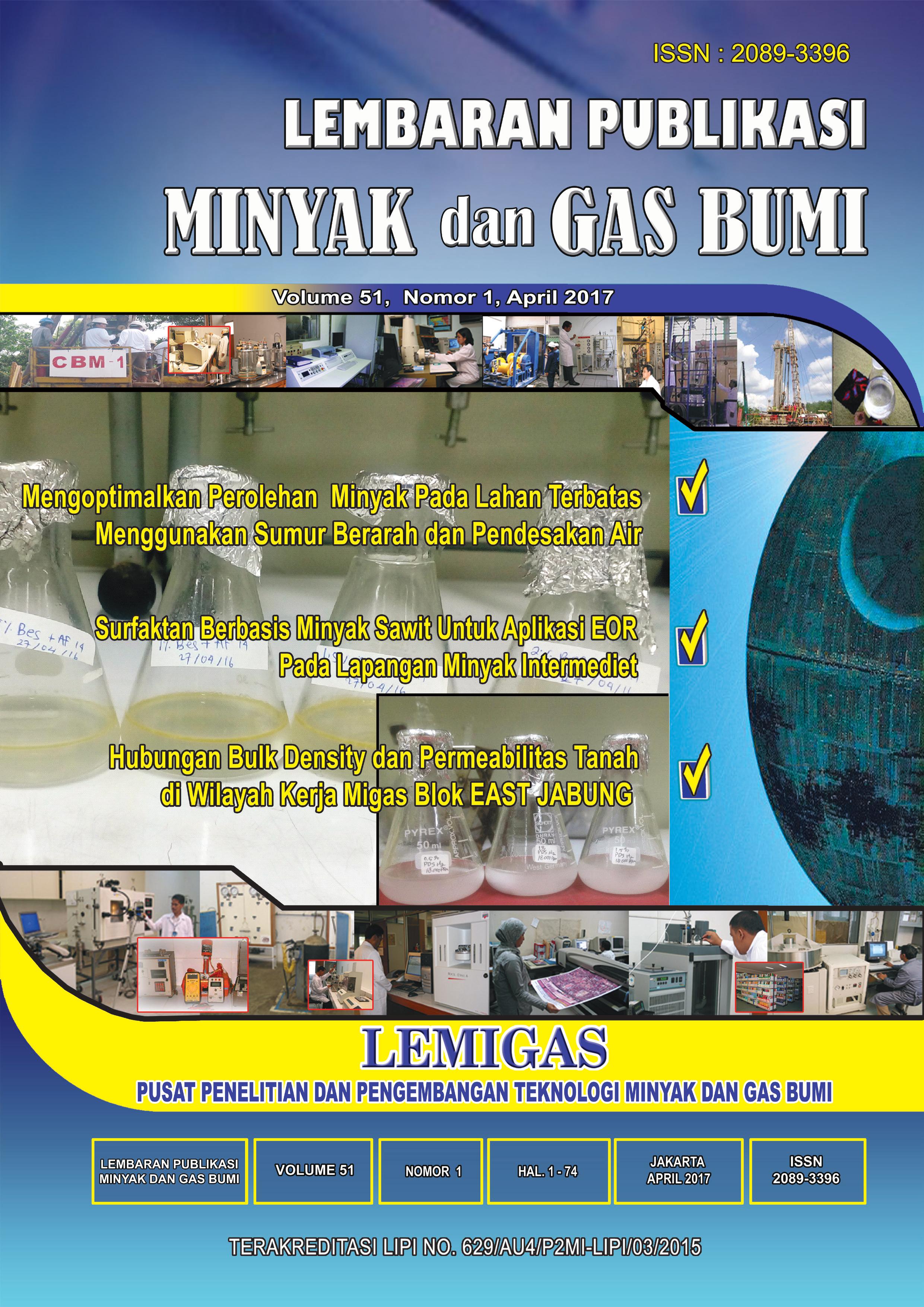ADSORBEN PENGERING GAS BUMI UNTUK MEMINIMALKAN KADAR AIR DALAM BAHAN BAKAR GAS (BBG) (Adsorbent Natural Gas Dryer to Minimize of Water Content in Gas Fuel)
DOI:
https://doi.org/10.29017/LPMGB.51.1.13Kata Kunci:
adsorben, pengering gas bumi, kadar air (adsorbent, natural gas drier, water vapor content)Abstrak
Batasan kadar air dalam bahan bakar gas bumi di Indonesia seringkali tidak dapat dipenuhi karena keterbatasan fasilitas yang dimiliki SPBG. Rancang bangun pengering gas bumi saat ini telah memiliki pangsa pasar di dalam negeri. Alat ini mampu menurunkan kadar air dalam gas bumi yang dimanfaatkan Stasiun Pengisian Bahan Bakar Gas (SPBG) dan industri. Penelitian ini memodifikasi karbon aktif sebagai adsorben dengan cara pembuatan pellet karbon aktif dengan menggunakan bentonit sebagai penyangga yang divariasikan dan dicampur dengan KOH lalu direndam pada suhu kamar. Adsorben dipanaskan lalu dibentuk pellet kemudian dipanaskan kembali pada suhu tinggi sebelum dikalsinasi. Setelah itu dilakukan karakterisasi untuk mengetahui sifat dan karakter pellet adsorben. Hasil uji menunjukkan bahwa pellet adsorben masih menyerap air hingga akhir pengujian mencapai 50% berat karbon aktif. Hasil penelitian diketahui bahwa adsorben ini dapat menurunkan kadar air dalam gas bumi dari 35 lb/MMScf menjadi minimum sekitar 5-6 lb/MMScf.
Limitation of the water content in the fuel gas in Indonesia very often can not be met due to the limited facilities owned in SPBGs. Design and build a gas drier has a market share in the country. This equipment is able to reduce the water content in the natural gas used Fuel Filling Station Gas (SPBGs) and industries. Initial experiments conducted tests on some types of adsorbents to determine the percent weight increase and manufacture of activated carbon pellets made using bentonite as a buffer with a variation of 20, 40 and 60% bentonite. Material mixed with KOH and then soaked at room temperature. The heated material is then formed pellets then reheated to a high temperature before calcined. After that characterization to determine the nature and character of adsorbent pellets. The test results showed that activated carbon can still absorb water until the end of the test, which reached 50% by weight of activated carbon. it is known that activated carbon absorbs the water and reduce the water content in the gas of 35 lb / MMscf to be a minimum of about 5-6 lb / MMscf.
Referensi
B.H. Hameed, A.T.M.Din, A.L.Ahmad, 2007. Adsorption of methylene blue onto bamboo based activated carbon: Kinetics and Equilibrium Studies. ELSEVIER
Design Guide No 1110-1-2, 2001.” Adsorption Design Guide”, Engineering and Design, Department of The Army U.S. Army Corps of Engineers, 1 March, 2001.
Dinesh, S. 2010. ” Development And Characterization Of Pellet Activated Carbon from New Precursor,” Thesis, Chemical Engineering, Department Of Chemical Engineering National Institute Of Technology Rourkela, 2010.
Eko Wiharto Setiawan dan Ade Lukman, 2001.“Pembuatan Pelet Karbon Aktif”, Departemen Teknik Kimia, Fakultas Teknologi Industri - ITB, 2001
GPSA Engineering Data Book Errata, 2004. “ Solid Desiccant Dehydration”, 12th edition.
Hassan A.A.Farag, M.Mohamed Ezzat, H. Amer, A.W. Nashed, 2011. Natural Gas Dehydration by Desiccant Materials. Alexandria Engineering Journal, Volume 50,Issue 4, December 2011, pages 431-439.
John K. Brennan, Kendall T. Thomson, and Keith E. Gubbins, 2001. “Adsorption of Water in Activated Carbons: Effects of Pore Blocking and Connectivity”; Department of Chemical Engineering, North Carolina State University,April 1, 2002
Journal of Hazardous Material, Vol. 141,Issue 3, 22 March 2007, pages 819-825.
Kobayashi,J., T. Imamura, M.Ichikawa, M. Kubota, F. Watanabe, N. Kobayashi and M. Hasatoni, 2006. “ Production of Activated Carbon for Water Vapor Adsorption by KOH and NaOH Activation”, Kagaku Kogaku Ronbunshu, 32 pp 186 - 189, 2006
Lisna R, Yayun A, Nata P dkk, 2014. “Kajian Rancangan Standar nasional Indonesia (RSNI) Spesifikasi CNG untuk Kendaraan Bermotor”. Laporan Akhir DIPA TA 2014 Pusat Penelitian dan Pengembangan Teknologi Minyak dan Gas Bumi “ LEMIGAS” Kementerian Energi dan Sumber Daya Mineral.
Maria Spiridon, Oana-Roxana Hauta1* Marius Sebastian Secula, Stelian Petrescu Tuiasi; 2012. “Preparation and Characterization of Some Porous Composite Materials for Water Vapor Adsorption”. Faculty of Chemical Engineering and Environmental Protection, Department of Chemical Engineering, Romania, REV. CHIM. (Bucharest) 63 No. 7, 2012.
Shimooka, S. M.Yamazaki, T. Tawetaki, 2007. “Improvement water adsorptivity of activated carbon for adsorption heat pump by hydrophilic treatment”, Proceedings of International Symposium on Eco Topia Scienci, 2007
Shimooka, S. M.Yamazaki, T. Tawetaki, 2006. “Development of hydrophilic Active Carbon for High Performance Adsorption Heat Pump”, Kagaku Kogaku Ronbunshu, 32 pp 528 -534, 2006











